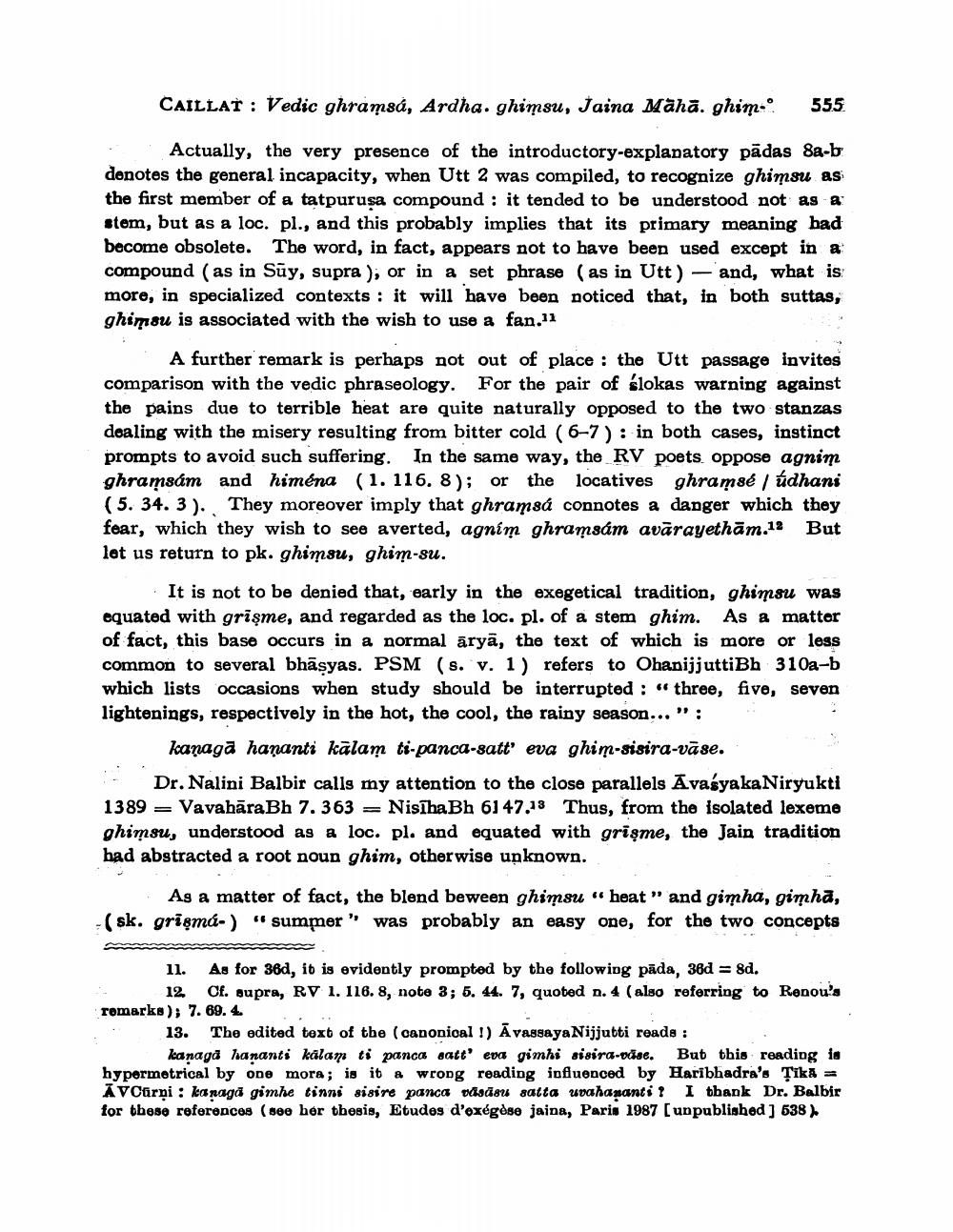________________
CAILLAT : Vedic ghramsá, Ardha. ghimsu, Jaina Mahā. ghimo
555
Actually, the very presence of the introductory-explanatory pādas 8a-b denotes the general incapacity, when Utt 2 was compiled, to recognize ghimsu as the first member of a tatpurusa compound : it tended to be understood not as a stem, but as a loc. pl., and this probably implies that its primary meaning had become obsolete. The word, in fact, appears not to have been used except in a compound (as in Sūy, supra ), or in a set phrase (as in Utt) — and, what is more, in specialized contexts : it will have been noticed that, in both suttas, ghimsu is associated with the wish to use a fan.11
A further remark is perhaps not out of place : the Utt passage invites comparison with the vedic phraseology. For the pair of blokas warning against the pains due to terrible heat are quite naturally opposed to the two stanzas dealing with the misery resulting from bitter cold (6-7): in both cases, instinct prompts to avoid such suffering. In the same way, the RV poets oppose agnim ghramsám and hiména (1. 116. 8); or the locatives ghramsé / údhans (5. 34. 3). They moreover imply that ghramsá connotes a danger which they fear, which they wish to see averted, agnim ghramsám avārayethām.12 But let us return to pk. ghimsu, ghim-su.
It is not to be denied that, early in the exegetical tradition, ghimsu was equated with grişme, and regarded as the loc. pl. of a stem ghim. As a matter of fact, this base occurs in a normal āryā, the text of which is more or less common to several bhāsyas. PSM (s. v. 1) refers to OhanijjuttiBh 310a-b which lists occasions when study should be interrupted : “ three, five, seven lightenings, respectively in the hot, the cool, the rainy season...";
kanaga hananti kalam ti-panca-satt' eva ghim-sisira-vāse.
Dr. Nalini Balbir calls my attention to the close parallels Āvasyaka Niryukti 1389 = Vavahāra Bh 7.363 = Nissha Bh 61 47.13 Thus, from the isolated lexeme ghimsu, understood as a loc. pl. and equated with grişme, the Jain tradition had abstracted a root noun ghim, otherwise unknown.
As a matter of fact, the blend beween ghimsu "heat” and gimha, gimha, (sk. grismá- )" summer' was probably an easy one, for the two concepts
11. As for 38d, it is evidently prompted by the following pāda, 38d = 8d.
12 Cf. supra, RV 1. 116. 8, note 3; 5. 44. 7, quoted n. 4 (also referring to Renou's romarks); 7. 69. 4.
13. The edited text of the (canonical !) ĀvassayaNijjutti reads :
kanaga hananti kalam ti panca satt' eva gimhi sisira-odse. But this reading in hypermotrical by one mora; is it a wrong reading influenced by Haribhadra's Tika - AVCárni : kanaga gimhe tinni sisire panca udisāsu salta uvahananti! I thank Dr. Balbir for these references (see bør thesis, Etudes d'exégèse jaina, Paris 1987 (unpublished ] 538 )




